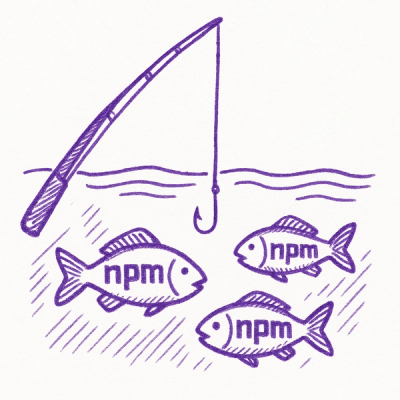
Security News
/Research
npm Phishing Email Targets Developers with Typosquatted Domain
A phishing attack targeted developers using a typosquatted npm domain (npnjs.com) to steal credentials via fake login pages - watch out for similar scams.
The shapefile npm package is used for reading and parsing shapefiles, which are a popular geospatial vector data format for geographic information system (GIS) software. This package allows you to read shapefiles and convert them into GeoJSON format, making it easier to work with geospatial data in JavaScript applications.
Reading Shapefiles
This feature allows you to read a shapefile and log its contents. The code opens a shapefile, reads its records, and logs each record to the console.
const shapefile = require('shapefile');
shapefile.open("path/to/shapefile.shp")
.then(source => source.read()
.then(function log(result) {
if (result.done) return;
console.log(result.value);
return source.read().then(log);
}))
.catch(error => console.error(error));Converting Shapefiles to GeoJSON
This feature allows you to convert a shapefile directly to GeoJSON format. The code reads a shapefile and converts its contents to GeoJSON, which is then logged to the console.
const shapefile = require('shapefile');
shapefile.read("path/to/shapefile.shp")
.then(geojson => console.log(JSON.stringify(geojson)))
.catch(error => console.error(error));shpjs is a JavaScript library for reading shapefiles in the browser. It can read both .shp and .dbf files and convert them to GeoJSON. Compared to shapefile, shpjs is more focused on client-side usage and is suitable for web applications that need to handle shapefiles directly in the browser.
Terraformer is a modular toolkit for working with geographic data in JavaScript. It includes tools for reading and writing GeoJSON, as well as converting between different geospatial formats. While it does not specifically focus on shapefiles, it provides a broader set of tools for geospatial data manipulation compared to shapefile.
gdal (Geospatial Data Abstraction Library) is a powerful library for reading and writing raster and vector geospatial data formats. The gdal npm package provides bindings to the GDAL library, allowing you to work with a wide range of geospatial data formats, including shapefiles. It is more comprehensive and feature-rich compared to shapefile, but also more complex to use.
In Node:
var shapefile = require("shapefile");
shapefile.open("example.shp")
.then(source => source.read()
.then(function log(result) {
if (result.done) return;
console.log(result.value);
return source.read().then(log);
}))
.catch(error => console.error(error.stack));
In a browser:
<!DOCTYPE html>
<script src="https://unpkg.com/shapefile@0.5"></script>
<script>
shapefile.open("https://cdn.rawgit.com/mbostock/shapefile/master/test/points.shp")
.then(source => source.read()
.then(function log(result) {
if (result.done) return;
console.log(result.value);
return source.read().then(log);
}))
.catch(error => console.error(error.stack));
</script>
In a terminal:
shp2json example.shp
For a live example, see bl.ocks.org/2dd741099154a4da55a7db31fd96a892. See also ndjson-cli for examples of manipulating GeoJSON using newline-delimited JSON streams.
This parser implementation is based on the ESRI Shapefile Technical Description and dBASE Table File Format. Caveat emptor: this is a work in progress and does not currently support all shapefile geometry types. It only supports dBASE III and has little error checking. Please contribute if you want to help!
In-browser parsing of dBASE table files requires TextDecoder, part of the Encoding living standard, which is not supported in IE or Safari as of September, 2016. See text-encoding for a browser polyfill.
TypeScript definitions are available in DefinitelyTyped: typings install dt~shapefile.
# shapefile.open(shp[, dbf[, options]]) <>
Returns a promise that yields an open shapefile source.
If typeof shp is “string”, opens the shapefile at the specified shp path. If shp does not have a “.shp” extension, it is implicitly added. If shp instanceof ArrayBuffer or shp instanceof Uint8Array, reads the specified in-memory shapefile. Otherwise, shp must be a Node readable stream in Node or a WhatWG standard readable stream in browsers.
If typeof dbf is “string”, opens the dBASE file at the specified dbf path. If dbf does not have a “.dbf” extension, it is implicitly added. If dbf instanceof ArrayBuffer or dbf instanceof Uint8Array, reads the specified in-memory dBASE file. If dbf is undefined and shp is a string, then dbf defaults to shp with the “.shp” extension replaced with “.dbf”; in this case, no error is thrown if there is no dBASE file at the resulting implied dbf. If dbf is undefined and shp is not a string, or if dbf is null, then no dBASE file is read, and the resulting GeoJSON features will have empty properties. Otherwise, dbf must be a Node readable stream in Node or a WhatWG standard readable stream in browsers.
If typeof shp or dbf is “string”, in Node, the files are read from the file system; in browsers, the files are read using streaming fetch, if available, and falling back to XMLHttpRequest. See path-source for more.
The follwing options are supported:
encoding - the dBASE character encoding; defaults to “windows-1252”highWaterMark - in Node, the size of the stream’s internal buffer; defaults to 65536# shapefile.read(shp[, dbf[, options]]) <>
Returns a promise that yields a GeoJSON feature collection for specified shapefile shp and dBASE table file dbf. The meaning of the arguments is the same as shapefile.open. This is a convenience API for reading an entire shapefile in one go; use this method if you don’t mind putting the whole shapefile in memory. The yielded collection has a bbox property representing the bounding box of all records in this shapefile. The bounding box is specified as [xmin, ymin, xmax, ymax], where x and y represent longitude and latitude in spherical coordinates.
The coordinate reference system of the feature collection is not specified. This library does not support parsing coordinate reference system specifications (.prj). Proj4js can parse most well-known text (WKT) specifications, but I’m not aware of any pure-JavaScript libraries that can convert these to OGC CRS URNs. (Please let me know if one exists!)
# source.bbox
The shapefile’s bounding box [xmin, ymin, xmax, ymax], where x and y represent longitude and latitude in spherical coordinates.
Returns a Promise for the next record from the underlying stream. The yielded result is an object with the following properties:
value - a GeoJSON feature, or undefined if the stream endeddone - a boolean which is true if the stream endedReturns a Promise which is resolved when the underlying stream has been destroyed.
# shp2json [options…] [file] <>
Converts the specified shapefile file to GeoJSON. If file is not specified, defaults to reading from stdin (with no dBASE file). For example, to convert to a feature collection:
shp2json example.shp
To convert to a geometry collection:
shp2json -g example.shp
To convert to newline-delimited features:
shp2json -n example.shp
To convert to newline-delimited geometries:
shp2json -ng example.shp
When --geometry or --ignore-properties is not used, the shapefile is joined to the dBASE table file (.dbf) file corresonding to the specified shapefile file, if any.
# shp2json -h
# shp2json --help
Output usage information.
# shp2json -V
# shp2json --version
Output the version number.
# shp2json -o file
# shp2json --out file
Specify the output file name. Defaults to “-” for stdout.
# shp2json -n
# shp2json --newline-delimited
Output newline-delimited JSON, with one feature or geometry per line.
# shp2json -g
# shp2json --geometry
Output a geometry collection instead of a feature collection or, in conjuction with --newline-delimited, geometry objects instead of feature objects. Implies --ignore-properties.
# shp2json --ignore-properties
Ignore the corresponding dBASE table file (.dbf), if any. Output features will have an empty properties object.
# shp2json --encoding encoding
Specify the dBASE table file character encoding. Defaults to “windows-1252”.
# shp2json --crs-name name
Specify the coordinate reference system name. This only applies when generating a feature collection; it is ignored when -n or -g is used. Per the GeoJSON specification, the name should be an OGC CRS URN such as urn:ogc:def:crs:OGC:1.3:CRS84. However, legacy identifiers such as EPSG:4326 may also be used.
This does not convert between coordinate reference systems! It merely outputs coordinate reference system metadata. This library does not support parsing coordinate reference system specifications (.prj).
FAQs
An implementation of the shapefile (.shp) spatial data format.
The npm package shapefile receives a total of 170,180 weekly downloads. As such, shapefile popularity was classified as popular.
We found that shapefile demonstrated a not healthy version release cadence and project activity because the last version was released a year ago. It has 1 open source maintainer collaborating on the project.
Did you know?

Socket for GitHub automatically highlights issues in each pull request and monitors the health of all your open source dependencies. Discover the contents of your packages and block harmful activity before you install or update your dependencies.

Security News
/Research
A phishing attack targeted developers using a typosquatted npm domain (npnjs.com) to steal credentials via fake login pages - watch out for similar scams.

Security News
Knip hits 500 releases with v5.62.0, refining TypeScript config detection and updating plugins as monthly npm downloads approach 12M.

Security News
The EU Cyber Resilience Act is prompting compliance requests that open source maintainers may not be obligated or equipped to handle.